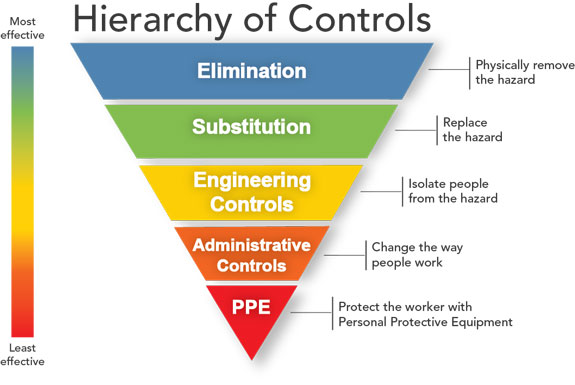Hazardous substances may take various forms including solids, liquids, gases, vapor, fumes, and mists. Entry into the body may result from various routes including inhalation, ingestion, absorption, and injection. It is therefore very important to identify the routes of entry and put measures towards eliminating the hazard or reducing the risk to avert future consequences that may result in diseases or death.

According to the Hierarchy of hazard control, the most effective control measure is to eliminate the use of hazardous substances in this context it will involve a total ban on asbestos use and the use of other environmentally friendly materials. Substitution involves the replacement of the hazards which will entail the removal of asbestos previously used. Engineering control can be used during the demolition of asbestos roofing when the encapsulation technique or wet methods can be used to prevent the fibers from being airborne. The administrative controls and Personal Protective Equipment are geared towards influencing behavior but intervention on the hazard. More than one control can be adopted for a task.

As defined by International Labour Organization (ILO) Asbestos Convention 1986(No.162), Asbestos means the fibrous form of mineral silicates belonging to rock-forming minerals of the serpentine group, i.e., chrysotile (white asbestos), and of the amphibole group, i.e., actinolite, amosite (brown asbestos, cummingtonite-grunerite), anthophyllite, crocidolite (blue asbestos), tremolite, or any mixture containing one or more of these. Historically asbestos was widely used due to its characteristic of the excellent electrical insulator and high heat resistant. Although some countries have banned the mining and use of asbestos some of the products in use still contain asbestos for instance motor vehicle clutch and brakes.
Current information states that asbestos fibers once inhaled can dislodge in the lungs causing diseases such as mesothelioma, asbestosis, and lung cancer. Mesothelioma is cancer that forms in the mesothelial tissue surrounding the lungs, chest cavity, and abdomen while asbestosis is a chronic respiratory disease caused by years of chronic inflammation and tissue scarring. The asbestos-related disease takes quite a long time to manifest after exposure.
Kenya has recently witnessed the renovation of buildings including residential and institutional where the asbestos roofing’s are replaced with more environmentally friendly roofing materials. The task is high risk as the asbestos has deteriorated over the years and if care is not taken the workers undertaking the work may themselves be victims of the process in later years. If the disposal is not done in a proper way and the asbestos finds its way to the dumpsites the public health is put in jeopardy as some will carry the asbestos, especially the sheets to their homes without the knowledge of the lurking danger.

In 2015 there was a report of disposed of asbestos that the public scrambled for in Kiambu county without the slightest knowledge of the danger they were exposing themselves to. Click the link for further reading Kiambu locals scramble for hazardous asbestos waste – The Standard (standardmedia.co.ke)
The National Environment Management Authority (NEMA) established under section 7 of the Environmental Management and Coordination Act, 1999 is mandated with ensuring that all renovation works involving asbestos are undertaken with due regard to the health and safety of the individuals as well as ensuring proper handling, transportation, and disposal. Environmental Management and Coordination (Waste management) regulation 2006 lists waste containing asbestos in the form of dust or fibers as hazardous. The regulation goes further to outline requirements for handling, transporting, and disposal of hazardous waste. The authority has specific guidelines on Asbestos known as National Guidelines on Safe Management of and Disposal of Asbestos 2013 requiring the asbestos waste generator to undertake an Environmental Impact Assessment (EIA) and a Hydrological study and work should commence only after the certificate has been issued. As institutions move to have the asbestos roofs replaced, concern for workers and public safety is of paramount importance. The asbestos once disturbed has the potential of producing dust that can easily find its way into the lungs if adequate control measures are not put in place. Some of the workplaces that have an increased risk include construction workers, waste handlers, and mechanics, especially those working on brakes and clutches.
Occupational Safety and Health Act (OSHA) 2007 Second Schedule-Prescribed Occupational Diseases names Primary malignant neoplasm of the mesothelium (diffuse mesothelioma) of the plaura or of the peritoneum as one of the occupational diseases that may result when a worker is working or handling of asbestos or any admixture of asbestos, manufacture or repair of asbestosis tiles or other articles containing or composed of asbestos and cleaning of any machinery or plant used in any of the foregoing operations and of any chambers, fixtures, and appliances for the collection of asbestos dust; Pneumoconiosis (including silicosis and asbestosis), byssinosis through the mining, quarrying, and dressing of sandstone, slate, and granite; any occupation involving exposure to asbestos dust; iron and steel foundry work; steel dressing; work in the pottery industry; the manufacture of refractory products such as silica bricks; any dusty process which results in pneumoconiosis.
It is a requirement by the Factories and Other Places of work (Medical Examination) Rules 2005 First Schedule (rule 4) Occupational Requiring Medical Examination for the occupier to ensure that workers undergo a medical examination which should be inclusive of clinical examination, lung function test, full-size chest x- rays and sputum cytology with an examination interval of pre-employment and annual in all work where asbestos is handled. WIBA Second Schedule Part ii also recognizes Silicosis, asbestos, or other fibrosis of the lungs caused by mineral dust.
Since its inception in 1974, The Kenya Bureau of Standards (KEBS) has remained the premier government agency for the provision of Standards, Metrology, and Conformity Assessment (SMCA) services. KEBS has developed standards on various use and prohibition of asbestos. Click the link for further reading https://www.kebs.org/
With regard to international treaties, Kenya ratified the Basel Convention in 2000. The Basel Convention on Control of Transboundary Movements of Hazardous Wastes and their Disposal was adopted on 22 March 1989 and entered into force on 5 May 1992. The Basel Convention classifies Asbestos as hazardous waste. Click the link for further reading 1400778_E_inside_OCE_signa.pdf (basel.int) The ILO has developed international instruments including The Occupational Cancer Convention,1974 (No.139), aimed at providing measures to be taken for the control and prevention of occupational hazards caused by carcinogenic substances and agents and The Asbestos Convention,1986 (No.162), that provide legal bases and practical guidance towards prevention of asbestos exposure to workers aimed at preventing asbestos-related diseases. Kenya is yet to ratify the ILO Asbestos Convention 1986 (No.162) and The Occupational Cancer Convention,1974 (No.139). Following the adoption of the Resolution Concerning asbestos by the ILO at the 95th Session in 2006, the ILO continues to push for the elimination of asbestos use and proper management of asbestos in use. Click the link for further reading
Resolution concerning asbestos, 2006 (ilo.org)
The Occupational Cancer Convention,1974 (No.139)Ratifications of ILO conventions: Ratifications by Convention Asbestos Convention 1986 (No.162) Convention C162 – Asbestos Convention, 1986 (No. 162) (ilo.org)
Though the Government of Kenya has taken initiatives toward adequate management of asbestos and protection of workers from exposure to asbestos, more need to be done for the public and workers in the informal sectors. As enshrined in the Kenyan Constitution of 2010 Article 41 a person has a right to fair labor practices and reasonable working conditions and 42 states that every person has a right to a clean and healthy environment. Click the link for further reading Const2010 (kenyalaw.org)
